

Sumo. In recent years, a number of high-profile controversies and scandals have rocked the sumo world, with a concomitant effect on its reputation and ticket sales.
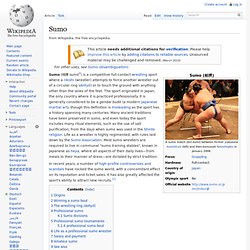
It has also greatly affected the sport's ability to attract new recruits.[1] Origins[edit] In addition to its use as a trial of strength in combat, sumo has also been associated with Shinto ritual, and even certain shrines carry out forms of ritual dance where a human is said to wrestle with a kami (a Shinto divine spirit); see Shinto origins of sumo. It was an important ritual at the imperial court. Representatives of each province were ordered to attend the contest at the court and fight. Cross-influence from other nations adjacent to Japan, sharing many cultural traditions, cannot be ruled out, as they also feature styles of traditional wrestling that bear resemblance to sumo.
Sumo wrestler Somagahana Fuchiemon, c. 1850 Sumo wrestling scene c. 1851. Kyūdō. A full draw, called "kai". History[edit] A Japanese archer with targets. Ink on paper, 1878. The beginning of archery in Japan is, as elsewhere, pre-historical. Kendo. Kendo (剣道, kendō?)
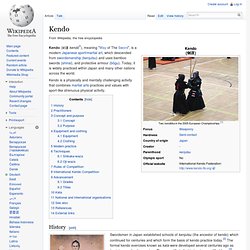
, meaning "Way of The Sword", is a modern Japanese sport/martial art, which descended from swordsmanship (kenjutsu) and uses bamboo swords (shinai), and protective armour (bōgu). Today, it is widely practiced within Japan and many other nations across the world. Kendo is a physically and mentally challenging activity that combines martial arts practices and values with sport-like strenuous physical activity. History[edit] Swordsmen in Japan established schools of kenjutsu (the ancestor of kendo) which continued for centuries and which form the basis of kendo practice today.[2] The formal kendo exercises known as kata were developed several centuries ago as kenjutsu practice for warriors.
The introduction of bamboo practice swords (shinai) and armour (bōgu) to sword training is attributed to Naganuma Shirōzaemon Kunisato during the Shotoku Era (1711–1715). In addition, the inscription on the gravestone of Yamada Heizaemon Mitsunori's (Ippūsai) (山田平左衛門光徳(一風斎)? Karate. Karate (空手?)
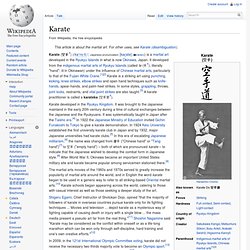
(/kəˈrɑːtiː/; Japanese pronunciation: [kaɽate] ( Karate developed in the Ryukyu Kingdom. It was brought to the Japanese mainland in the early 20th century during a time of cultural exchanges between the Japanese and the Ryukyuans. It was systematically taught in Japan after the Taisho era.[4] In 1922 the Japanese Ministry of Education invited Gichin Funakoshi to Tokyo to give a karate demonstration. In 1924 Keio University established the first university karate club in Japan and by 1932, major Japanese universities had karate clubs.[5] In this era of escalating Japanese militarism,[6] the name was changed from 唐手 ("Chinese hand" or "Tang hand")[7] to 空手 ("empty hand") – both of which are pronounced karate – to indicate that the Japanese wished to develop the combat form in Japanese style.[8] After World War II, Okinawa became an important United States military site and karate became popular among servicemen stationed there.[9]
Judo. History and philosophy[edit] Early life of the founder[edit] The early history of judo is inseparable from its founder, Japanese polymath and educator Jigoro Kano (嘉納 治五郎, Kanō Jigorō?
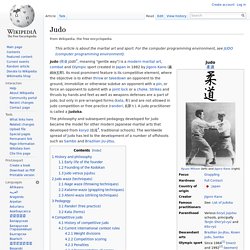
, 1860–1938), born Shinnosuke Kano (嘉納 新之助, Kanō Shinnosuke?). Kano was born into a relatively affluent family. His father, Jirosaku, was the second son of the head priest of the Shinto Hiyoshi shrine in Shiga Prefecture. Jigoro Kano had an academic upbringing and, from the age of seven, he studied English, Japanese calligraphy (書道, shodō?) Early attempts to find a jujutsu teacher who was willing to take him on met with little success. In 1877, as a student at the Tokyo-Kaisei school (soon to become part of the newly founded Tokyo Imperial University), Kano learned that many jujutsu teachers had been forced to pursue alternative careers, frequently opening Seikotsu-in (整骨院?
Founding of the Kodokan[edit] In February 1882, Kano founded a school and dojo at the Eisho-ji (永昌寺?) Aikido. Modern Japanese martial art Aikido (合気道, aikidō, Japanese pronunciation: [aikiꜜdoː], kyūjitai: 合氣道) is a modern Japanese martial art developed by Morihei Ueshiba as a synthesis of his martial studies, philosophy and religious beliefs.
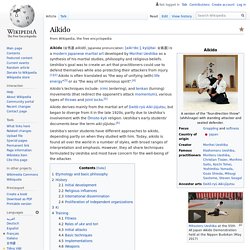
Ueshiba's goal was to create an art that practitioners could use to defend themselves while also protecting their attackers from injury.[1][2] Aikido is often translated as "the way of unifying (with) life energy"[3] or as "the way of harmonious spirit".[4] Mitsuteru Ueshiba at the 55th All Japan Aikido Demonstration held at the Nippon Budokan (May 2017) Aikido derives mainly from the martial art of Daitō-ryū Aiki-jūjutsu, but began to diverge from it in the late 1920s, partly due to Ueshiba's involvement with the Ōmoto-kyō religion. Ueshiba's early students' documents bear the term aiki-jūjutsu.[6] Ueshiba's senior students have different approaches to aikido, depending partly on when they studied with him.
Etymology and basic philosophy[edit]